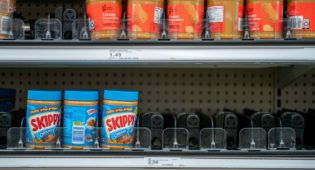The Friday Checkout: The unexpected impacts of weather on supply chain
By Grocery Dive Staff
An Albertsons senior director shared how predictive weather-driven demand analytics can have surprising results for product forecasting during a session at the National Retail Federation’s conference.

Peanut butter is seen on a shelf in a Target store on July 8, 2022, in Houston. Consumer goods continue seeing shortages as the country grapples with ongoing supply chain issues stemming from the pandemic. Brandon Bell via Getty Images
The Friday Checkout is a weekly column providing more insight on the news, rounding up the announcements you may have missed and sharing what’s to come.
The weather’s impact on consumer behavior and product demand can be a no-brainer. Warm temperatures typically spur demand for cold beverages and ice cream sales, for instance.
But then there are the weather-driven behaviors that retailers and restaurants wouldn’t typically expect. A Tuesday session at the National Retail Federation’s annual conference in New York that included an H-E-B vice president, Albertsons senior director and Chipotle Mexican Grill data science manager explored how predictive weather-driven demand analytics can help better anticipate customers’ needs.
Jeremy Elster, data science manager at Chipotle, noted it’s not surprising when delivery demand spikes when it’s raining. In the Northeast region, it’s common for Albertsons to see demand for chilis and soups to spike when summer turns to fall, said Tyler Scott, senior director of demand planning and retail support at Albertsons.
Other weather-based triggers, though, are not as obvious. For example, Scott said peanut butter demand fluctuates with “spells” in the weather. It’s not immediately clear why that is.
Coffee sales fluctuate 5% on average due to the weather and time of the year, with markets in the Northeast sometimes seeing coffee demand 10% above typical levels when cooler temperatures carry over into spring, according to Planalytics, a provider of business weather intelligence services that also participated in the session.
Planalytics is positioning itself as a way to help companies discover and navigate those unexpected and seemingly weather-driven behaviors. The company’s pitch is that its technology helps clients capture additional sales and margins by having a better grasp on weather volatility.
It’s not just product demand: Foot traffic can dramatically rise and fall around severe weather, especially at convenience stores, Planalytics has noted.
H-E-B has piloted the technology across “select categories,” said Ross Giambalvo, the grocer’s vice president of inventory management. The Texas grocer is getting a better understanding of how weather volatility can impact different categories, Giambalvo said.
The panelists noted overlapping weather data with demand forecasting can provide a better understanding of product demand — influencing inventory management and consumer pricing.
To read the original article, Click Here.
For more information about Planalytics, Contact Us.
